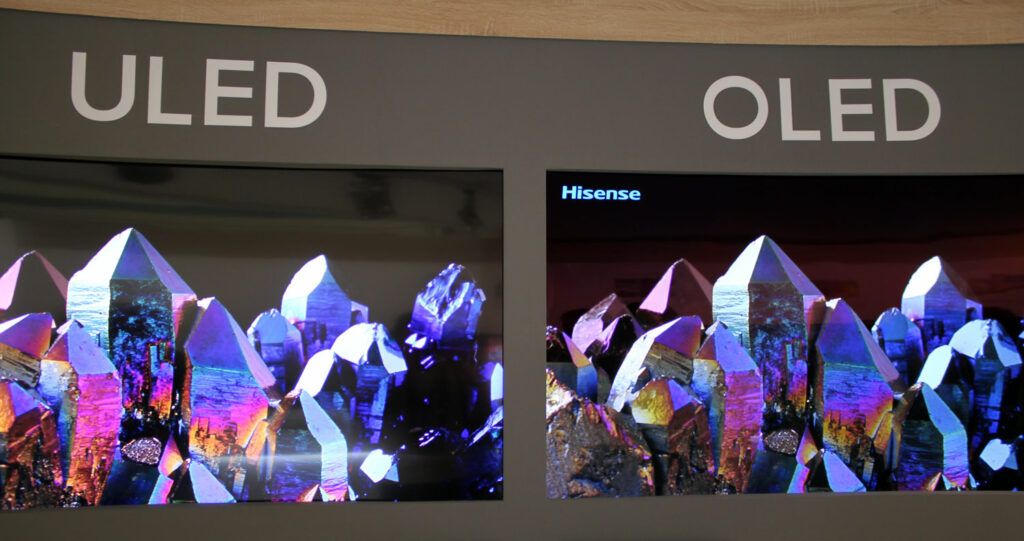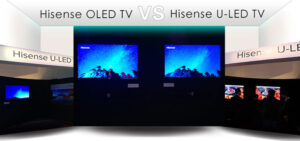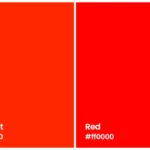Hybrid Light-Emitting Device is shortened to OLED in several contexts. This indicates that each image in Flat Screen tv provides its light, each of which is capable of being switched off independently. OLED televisions do not have the same level of brightness as LED screens, which is one of the major drawbacks of uled & OLED for gaming.
In contrast, you will discover that your monthly energy costs are likely to be greater with an AMOLED TV since they use more electricity. Hisense uses the term ULED, which stands for Ultra LED, to designate Extremely Fast Movement Rate, Ultimate Regional Dimming, Ultimate 4K Quality, and Ultra-wideband Colour Gamut.
A group of inventions uled & OLED & uhd that have been granted patents is what this word refers to. ULED televisions, on the other hand, are noticeably brighter, more detailed, and provide a broader range of colors to choose from on the screen.
Key Differences Simplified
Uled: When seen, an image that is identical to that of an OLED display may be generated by a ULED TV by using Quantum Dot Technology as well as a broad color range.
Oled: To create an image on the screen, LED televisions require the use of a sequence of lighting and materials, while OLED televisions make use of molecular and illumination created by electricity to create a showcase of an image.
Meaning
| Uled | Oled |
| ULED televisions always have a resolution of 4K Extreme High. This indicates that you have four times the amount of pixels that are present in a full HD TV, which results in visuals that are more distinct and vivid. | The term “Organic Light-Emitting Diode” can sometimes be abbreviated to “OLED.” This indicates how each particle in OLED TVs is capable of delivering its light, and this illuminating may be switched off independently. |
Usage Examples
- Example 1: ULED Screens also feature a technology called UltraSmooth Movement, which makes sure that the movies you watch aren’t choppy and that visuals don’t have halo effects.
- Example 2: OLED TVs may be as thin as a micrometer since they do not need a backlight. This is possible because every single display in an OLED TV can be switched to active or off. OLEDs may also be designed with a layout that does not have bezels, which enables the user to maintain their attention on the image being shown.
Other Similar Terms
How good is ULED?

Regarding the display resolution, there is no such thing as a non-4K Extreme High ULED Television. That equates to a resolution of 3,860 pixels by 2,180. When contrasted to a Hd Quality TV, this amounts to a whopping 4 times the number of pixels. If you have the correct 4K content, it will result in a picture that is more crisp and precise than any other you have ever experienced.
What is better than OLED?

The sharpest QLED and LCD TVs can grow even brighter than the sharpest quantum uled & OLED models, which is a benefit in very light settings and for viewing HDR material.
How long will an OLED TV last?

It is expected that an OLED television would have a longevity of at least six to eight years. You would consider watching television between four and six hours a day, with a maximum of eight hours per day. If someone is viewing extra, Pantalla uled vs OLED then I’ll suggest to the people, “Have a bit more of life,” so please believe it.
Is Uled the same as Qled?

The distinction between ULED screens and QLED screens, which employ Quantum Dot technology to provide a superior browsing experience, is that ULED panels are standard LED ones however, they have a few unique adjustments made to them to improve the image and the watching experience.
Can sunlight damage OLED TV screens?

OLED displays are extremely vulnerable to the severe environmental factors that can be found outside. These conditions include being exposed to direct sunshine, as well as Ultraviolet radioactivity and storage heat, which can cause a reduction in brightness and life expectancy, image contraction, and lasting injuries or mechanical failure of the board.
Do OLED screens break easily?

It seems that OLED panels are considerably more likely to shatter or become broken whenever the glass that covers them cracks than Led TVs are. OLED panels are extremely thin, and this contributes significantly to the stiffness of the screens.
It is possible that you may be greeted with a black display if your phone is subjected to significant bending or is broken with sufficient force.
Can I touch the ULED screen?
Yes. This problem is not exclusive to LG and affects all ULED televisions. When you contact a ULED display, you won’t experience the similar biofilm effects that occur if you contact an LCD screen since the outside layer of a ULED display is composed of glass, a similar material that an Lcd display is made of.
- Thus Far vs So Far [Which is Correct?] - September 3, 2023
- Uled vs Oled in 2024 [Which is Better?] - September 3, 2023
- Scarlet vs Red [Difference Explained] - September 3, 2023

![Uled vs Qled in 2024 [Which is Better?] Uled vs Qled](https://bitdifference.com/wp-content/uploads/2022/11/ULED-vs-QLED-a1c0f3615a704c4cb93a662e475ded55-150x150.jpg)
![OLED vs AMOLED in 2024 [Which is Better?] Oled vs Amoled 1](https://bitdifference.com/wp-content/uploads/2023/07/oled-vs-amoled-1-150x150.jpg)
![Monitor vs TV in 2024 [Which is Better?] Monitor vs TV](https://bitdifference.com/wp-content/uploads/2022/11/maxresdefault-5.jpg)
![QHD vs 4K in 2024 [Which is Better?] QHD vs 4K 1](https://bitdifference.com/wp-content/uploads/2023/07/2020-05-09_9-02-23-150x150.webp)
![QHD vs IPS in 2024 [Which is Better?] QHD vs IPS 1](https://bitdifference.com/wp-content/uploads/2023/07/IPS-vs-OLED-150x150.jpg)
![Gigabyte vs Gigabit in 2024 [Simply Explained] Gigabit-vs-gigabyte](https://bitdifference.com/wp-content/uploads/2022/11/Gigabit-vs-gigabyte-150x150.png)

